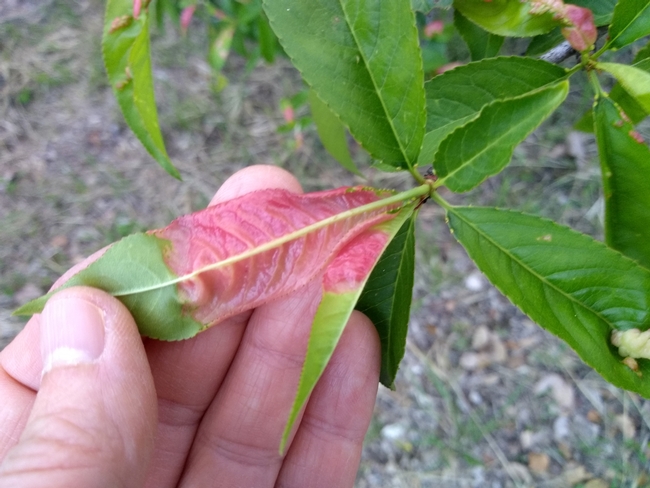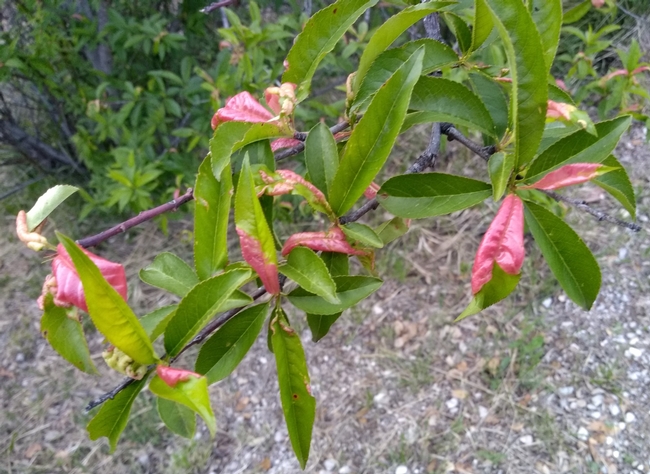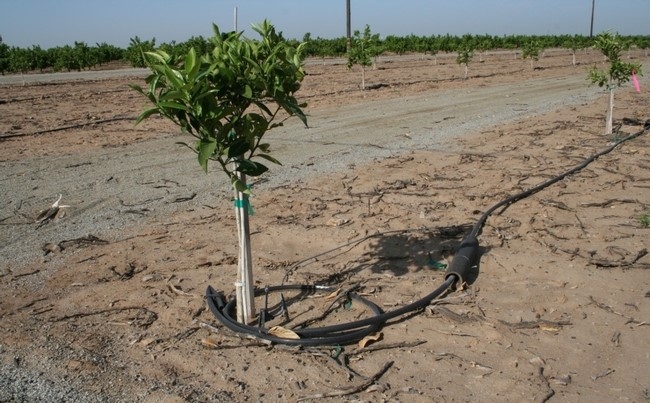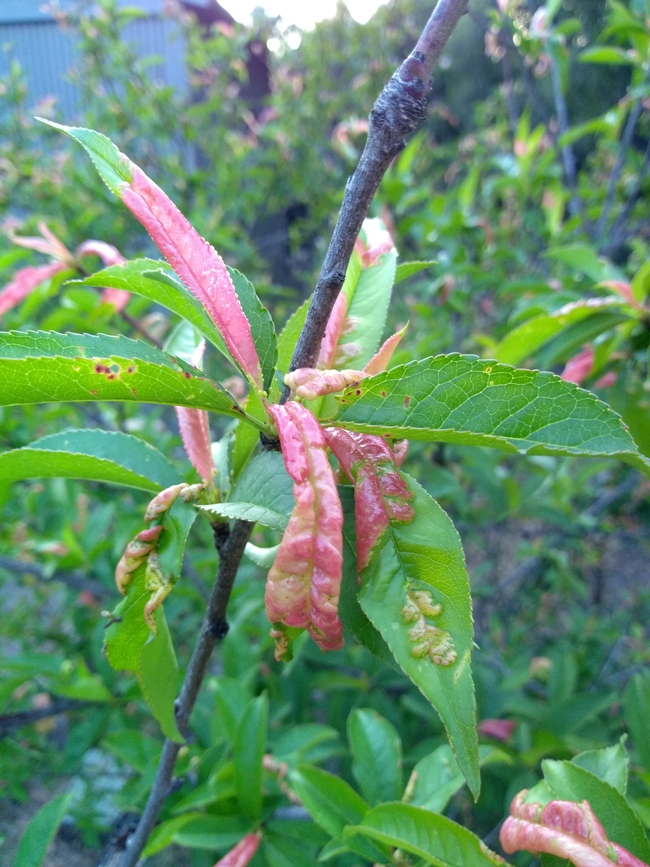
Posts Tagged: tree health
What is wrong with my peach tree?
In this weekly blog, Dr. Annemiek Schilder, Director, UCCE Ventura County and Hansen Agricultural Research and Extension Center, shares her observations about the natural world across the seasons. As she says:
"Gently observing your surroundings with curiosity will teach you some amazing things. There are so many fascinating things happening under our noses, only wanting for an observant eye."
"What is wrong with my peach tree?"
Many people have probably asked this question as they have stared in concerned wonder at the distorted leaves of their peach trees. From a distance the striking color patterns may even look like peculiar flowers. Peach leaf curl is a disease of peach and nectarine trees caused by the fungus Taphrina deformans, an apt name for this fungus. Ornamental peach trees, grown for their beautiful blooms, are also susceptible to this disease.
Peach leaf curl is a common plant disease featured in many plant pathology textbooks. It may well have been the disease that convinced me to become a plant pathologist (a plant doctor) as I peered with increasing fascination at its structures under the microscope.
Allow me to digress a little to discuss that great invention: the microscope. In the late 1600's, Antonie van Leeuwenhoek, a self-taught Dutch scientist, developed a single lens microscope with up to 300 times magnification, allowing observation of bacteria for the first time. He called them “little animals”. However, it would take another 200 years before bacteria and fungi were officially recognized as causes of disease in animals and plants, laying the groundwork for modern-day medicine.
The name of this disease, peach leaf curl, is quite descriptive as the fungus causes leaves to curl and develop blister-like areas. Rainy, cool springs promote infection - as well as spore production - on infected leaves. Spores are spread by wind and rainsplash to other leaves, where they can cause new infections. The disease is not only unsightly –except to the eyes of a plant pathologist, of course - but also causes diseased leaves to drop prematurely, which weakens the tree and may lower fruit yield. In severe cases, repeated defoliations can kill a tree.

Taphrina deformans spores are produced in elongated structures called asci, a Latin word meaning “sacs”.
Have you noticed that Latin is used a lot for botanical descriptions? This is because Latin is a “dead” language and thus grammatically stable.
Taphrina's asci are lined up in layers on the leaf surface without any protective covering; therefore they are termed “naked asci”. So guess what name my Plant Pathology student volleyball team chose? Indeed, our t-shirts sported botanically correct drawings of Taphrina's asci, causing the other teams to think of us a bunch of weird science nerds. Nerds who played a pretty good game of volleyball mind you!
So what can you do to keep your trees healthy? Here are a few tips.
- If you are thinking of planting a peach or nectarine tree, investigate whether resistant varieties are available so you can avoid the problem altogether.
- For established trees, fall pruning of diseased shoots may help.
- Also for established trees, (organic) copper fungicide sprays in late fall after leaf drop and before budbreak in the spring may help.
- Addition of a horticultural oil may improve spray coverage. Be sure to follow the instructions on the label carefully.
If your tree got whacked by the disease, infected leaves will fall off and new leaves will develop but this requires the tree to expend additional energy. A foliar fertilizer application as well as fruit thinning can help the tree recover.

Related Reading:
Soil and Water pH Affect Root Health in HLB Citrus
At the recent HLB Conference in Florida a paper was given that reinforces the need for appropriate soil and water pH to maximize root density and tree health. The industry there is dominated by a range of rootstocks and by Valencia-like varieties. Jim Graham and colleagues have shown that pH contributes to orchard health in their HLB situation. This should be a reminder for California growers for general tree health. Florida soils tend to be more coarse than soils found in many California orchards. It's much harder to change soil pH with acidified irrigation water with heavier textured soils.
4.b.1 Soil and water acidification sustain root density of huanglongbing-infected trees in Florida
Jim GRAHAM, Kayla GERBERICH, Diane BRIGHT, Evan JOHNSON
University of Florida, Citrus Research and Education Center, Lake Alfred, Florida, USA
Abstract: Early symptoms of HLB include fibrous root loss and leaf blotchy mottle, followed by premature fruit and leaf drop, and yield decline. As a consequence of initial bacterial infection of fibrous roots, a 30-50% reduction in fibrous root density and elevated soil Phytophthora populations were detected in field surveys. Continued sampling of Hamlin and Valencia orange trees on Swingle citrumelo rootstock in different stages of HLB decline revealed that root loss occurs in two stages. The second phase of root loss (70-80%) begins at the early stage of tree canopy thinning resulting from leaf drop and branch dieback. A more extensive survey of HLB-affected groves indicated that greater decline in fibrous root health and expression of HLB symptoms is observed where irrigation water is high in bicarbonates (> 100 ppm) and/or soil pH > 6.5. HLB symptom expression of trees on different rootstocks follows the known intolerance to bicarbonate (Swingle citrumelo > Carrizo citrange > sour orange > Cleopatra mandarin). Acidification of irrigation water in central ridge and south central flatwoods Valencia orange groves on Swingle citrumelo rootstock for three seasons has maintained soil pH below 6.5 on the flatwoods and 6.0 on ridge. Over the last three seasons of survey, root density as an index of root heath has been sustained. Phytophthora populations remain below the damaging level in ridge groves and in flatwoods increase to damaging levels coincident with the fall root flush but drop back to non-damaging levels for remainder of the season. Compared to the 2013-14 season, yields in the ridge blocks have increased up to 4% and on the flatwoods have increased up to 22%.Growers using acidification treatments with sulfuric and/or N-phuric acid for the last 3 seasons report an average cost of $60 per acre. This cost will analyzed in relation to yield response to provide a cost benefit of acidification
Non-Technical Summary: Managements have been implemented to reduce soil, nutrient and water stress, and Phytophthora root rot. They include frequent irrigation cycles, fertigation and acidification of irrigation water and soil to reduce rhizosphere pH, and fungicides. Root density of trees under these practices fluctuates seasonally and annually but has not declined over the past 3 years. Trees managed with soil acidification and fertigation have steadily recovered in health and yield.
http://www.icc2016.com/images/icc2016/downloads/Abstract_Book_ICC_2016.pdf

citrus

